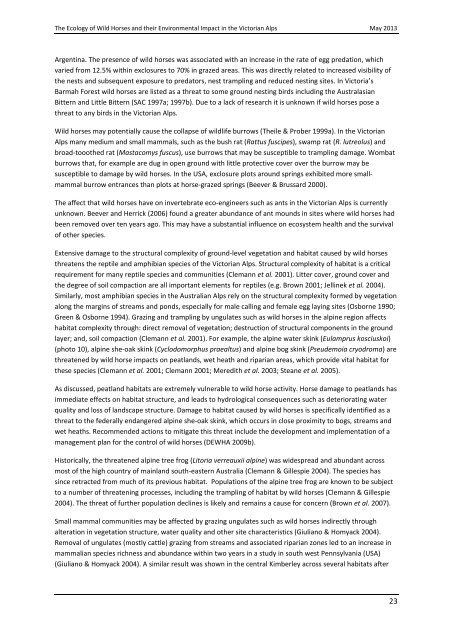The Ecology of Wild Horses and their Environmental ... - Parks Victoria
The Ecology of Wild Horses and their Environmental ... - Parks Victoria
The Ecology of Wild Horses and their Environmental ... - Parks Victoria
Create successful ePaper yourself
Turn your PDF publications into a flip-book with our unique Google optimized e-Paper software.
<strong>The</strong> <strong>Ecology</strong> <strong>of</strong> <strong>Wild</strong> <strong>Horses</strong> <strong>and</strong> <strong>their</strong> <strong>Environmental</strong> Impact in the <strong>Victoria</strong>n Alps May 2013Argentina. <strong>The</strong> presence <strong>of</strong> wild horses was associated with an increase in the rate <strong>of</strong> egg predation, whichvaried from 12.5% within exclosures to 70% in grazed areas. This was directly related to increased visibility <strong>of</strong>the nests <strong>and</strong> subsequent exposure to predators, nest trampling <strong>and</strong> reduced nesting sites. In <strong>Victoria</strong>’sBarmah Forest wild horses are listed as a threat to some ground nesting birds including the AustralasianBittern <strong>and</strong> Little Bittern (SAC 1997a; 1997b). Due to a lack <strong>of</strong> research it is unknown if wild horses pose athreat to any birds in the <strong>Victoria</strong>n Alps.<strong>Wild</strong> horses may potentially cause the collapse <strong>of</strong> wildlife burrows (<strong>The</strong>ile & Prober 1999a). In the <strong>Victoria</strong>nAlps many medium <strong>and</strong> small mammals, such as the bush rat (Rattus fuscipes), swamp rat (R. lutreolus) <strong>and</strong>broad-tooothed rat (Mastacomys fuscus), use burrows that may be susceptible to trampling damage. Wombatburrows that, for example are dug in open ground with little protective cover over the burrow may besusceptible to damage by wild horses. In the USA, exclosure plots around springs exhibited more smallmammalburrow entrances than plots at horse-grazed springs (Beever & Brussard 2000).<strong>The</strong> affect that wild horses have on invertebrate eco-engineers such as ants in the <strong>Victoria</strong>n Alps is currentlyunknown. Beever <strong>and</strong> Herrick (2006) found a greater abundance <strong>of</strong> ant mounds in sites where wild horses hadbeen removed over ten years ago. This may have a substantial influence on ecosystem health <strong>and</strong> the survival<strong>of</strong> other species.Extensive damage to the structural complexity <strong>of</strong> ground-level vegetation <strong>and</strong> habitat caused by wild horsesthreatens the reptile <strong>and</strong> amphibian species <strong>of</strong> the <strong>Victoria</strong>n Alps. Structural complexity <strong>of</strong> habitat is a criticalrequirement for many reptile species <strong>and</strong> communities (Clemann et al. 2001). Litter cover, ground cover <strong>and</strong>the degree <strong>of</strong> soil compaction are all important elements for reptiles (e.g. Brown 2001; Jellinek et al. 2004).Similarly, most amphibian species in the Australian Alps rely on the structural complexity formed by vegetationalong the margins <strong>of</strong> streams <strong>and</strong> ponds, especially for male calling <strong>and</strong> female egg laying sites (Osborne 1990;Green & Osborne 1994). Grazing <strong>and</strong> trampling by ungulates such as wild horses in the alpine region affectshabitat complexity through: direct removal <strong>of</strong> vegetation; destruction <strong>of</strong> structural components in the groundlayer; <strong>and</strong>, soil compaction (Clemann et al. 2001). For example, the alpine water skink (Eulamprus kosciuskoi)(photo 10), alpine she-oak skink (Cyclodomorphus praealtus) <strong>and</strong> alpine bog skink (Pseudemoia cryodroma) arethreatened by wild horse impacts on peatl<strong>and</strong>s, wet heath <strong>and</strong> riparian areas, which provide vital habitat forthese species (Clemann et al. 2001; Clemann 2001; Meredith et al. 2003; Steane et al. 2005).As discussed, peatl<strong>and</strong> habitats are extremely vulnerable to wild horse activity. Horse damage to peatl<strong>and</strong>s hasimmediate effects on habitat structure, <strong>and</strong> leads to hydrological consequences such as deteriorating waterquality <strong>and</strong> loss <strong>of</strong> l<strong>and</strong>scape structure. Damage to habitat caused by wild horses is specifically identified as athreat to the federally endangered alpine she-oak skink, which occurs in close proximity to bogs, streams <strong>and</strong>wet heaths. Recommended actions to mitigate this threat include the development <strong>and</strong> implementation <strong>of</strong> amanagement plan for the control <strong>of</strong> wild horses (DEWHA 2009b).Historically, the threatened alpine tree frog (Litoria verreauxii alpine) was widespread <strong>and</strong> abundant acrossmost <strong>of</strong> the high country <strong>of</strong> mainl<strong>and</strong> south-eastern Australia (Clemann & Gillespie 2004). <strong>The</strong> species hassince retracted from much <strong>of</strong> its previous habitat. Populations <strong>of</strong> the alpine tree frog are known to be subjectto a number <strong>of</strong> threatening processes, including the trampling <strong>of</strong> habitat by wild horses (Clemann & Gillespie2004). <strong>The</strong> threat <strong>of</strong> further population declines is likely <strong>and</strong> remains a cause for concern (Brown et al. 2007).Small mammal communities may be affected by grazing ungulates such as wild horses indirectly throughalteration in vegetation structure, water quality <strong>and</strong> other site characteristics (Giuliano & Homyack 2004).Removal <strong>of</strong> ungulates (mostly cattle) grazing from streams <strong>and</strong> associated riparian zones led to an increase inmammalian species richness <strong>and</strong> abundance within two years in a study in south west Pennsylvania (USA)(Giuliano & Homyack 2004). A similar result was shown in the central Kimberley across several habitats after23
















